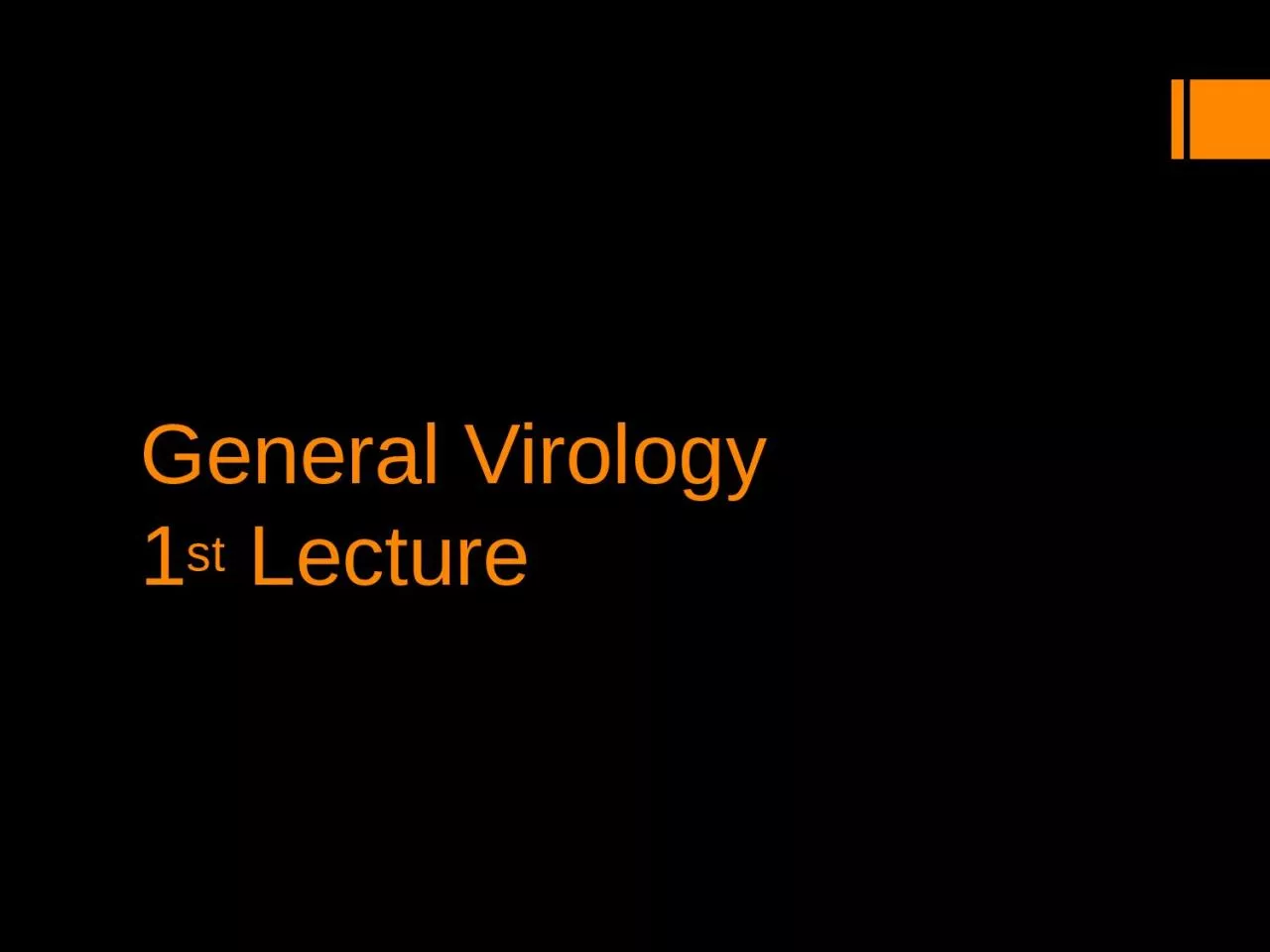

Topics Week l Introduction and General characters of viruses History definition and importance of study Viral structure Virus structure and morphology composition ID: 1036668
Download Presentation The PPT/PDF document "General Virology 1 st Lecture" is the property of its rightful owner. Permission is granted to download and print the materials on this web site for personal, non-commercial use only, and to display it on your personal computer provided you do not modify the materials and that you retain all copyright notices contained in the materials. By downloading content from our website, you accept the terms of this agreement.
1. General Virology1st Lecture
2. TopicsWeek l: -Introduction and General characters of viruses (History ,definition, and importance of study) Viral structure Virus structure and morphology composition and function of viral structure Week 2: Virus Architecture and Nomenclature Viral shape(Symmetry) and different figure of virus Classification of Animal Viruses (ICV and Baltimore scheme)Week 3: Virus replication StrategiesPrincipal events involved in replication: Adsorption, penetration, uncoating nucleic acid and protein synthesis, assembly, maturation and release.
3. Week 4 : Chemical and physical agent reaction To discuss the effect of pH, temperature ,Heat, cold and salts upon Viral activities. Viral Immunopathology-Viral Immune response and viral evasion Mechanisms Week 5 : Laboratory Diagnosis of Virus Infections (Method of Diagnosis) Direct method In Direct method Serological and molecular methodWeek 6 : Double stranded DNA Virus (Adenoviruses, Herpesviruses, Poxviruses Week 7: Single strand DNA viruses (+ sense) DNA (e.g. Parvoviruses)Week 8: Positive single strand (+)ssRNA viruses (+ sense) RNA (e.g. Picornaviruses, Togaviruses)Week 9: Double strand RNA viruses (e.g. Reoviruses)
4. Week 10 : Negative single strand (−)ssRNA viruses (antisense) RNA (e.g. Orthomyxoviruses, Rhabdoviruses) Week 11 : Single strand RNA-RT viruses (+ sense) RNA with DNA intermediate in life-cycle (e.g. Retroviruses) Week 12 : Double strand DNA-RT viruses (e.g. Hepadnaviruses) Week 13: Viral Persistence: Chronic & Latent Virus Infections, Effect of Host Age.Week 14: Antiviral Chemotherapy, Viral Vaccines.
5. General VirologyIntroduction to the viruses
6. VirusesViruses= Latin for ‘slimy liquid’ or ‘poison’ are non-cellular or Acellular infectious agentsVirology=study of virusesVirologists =scientists who study viruses
7. Why Study VirusesViruses are capable of infecting all forms of life Vertebrates, prokaryotes, fungi, algaeMost abundant form of life-Bacteriophages are extremely abundantRecognizing the shape, size, and structure of different viruses is critical to the study of diseaseExcellent molecular biology tools
8. Some viruses are useful:-• Phage typing of bacteria: Some groups of bacteria, such as some Salmonella species, are classified into strains on the basis of the spectrum of phages to which they are susceptible. • Sources of enzyme: A number of enzymes used in molecular biology are virus enzymes. Examples include reverse transcriptase from retroviruses and RNA polymerases from phages.• Pesticides: Some insect pests are controlled with baculoviruses and myxoma virus.• Anti-bacterial agent: phages were used to treat some bacterial infections of humans.• Anti-cancer agents: Genetically modified strains of viruses, such as herpes simplex virus and vaccinia virus, are being investigated for treatment of cancers.• Gene vectors for protein production: Viruses such as certain adenoviruses are used as vectors to take genes into animal cells growing in culture. • Gene vectors for treatment of genetic disease
9. Evolutionary Origin of VirusesThe origin of viruses is not known. There are profound differences among the DNA viruses, the RNA viruses, and viruses that utilize both DNA and RNA as their genetic material during different stages of their life cycle. It is possible that different types of agents are of different origins. Two theories of viral origin can be summarized as follows:Viruses may be derived from DNA or RNA nucleic acid components of host cells that became able to replicate autonomously and evolve independently. They resemble genes that have acquired the capacity to exist independently of the cell.(2) Viruses may be degenerate forms of intracellular parasites. There is no evidence that viruses evolved from bacteria, though other obligatory intracellular organisms, e.g. rickettsia and chlamydia presumably did so. However, poxviruses are so large and complex that they might represent evolutionary products of some cellular ancestor.
10. The Position of Viruses in the Biological SpectrumViruses are infectious agents with both living and nonliving characteristics. 1. Living characteristics of viruses (a). They reproduce at a fantastic rate, but only in living host cells (b). They can mutate.
11. The Position of Viruses in the Biological Spectrum2. Nonliving characteristics of viruses They are acellular, that is, no cytoplasm or no cellular organelles. No metabolism on their own and must replicate using the host cell's metabolic machinery.
12. Edward Jenner 1796 VaccinationsCowpox cross protection against small pox (Variola virus)Similar infection in cowsMilkmaids infected by cowpox do not get smallpoxHistory & Landmarks in Virology
13. Used the pus from cowpox lesions to inoculate and prevent smallpoxTermed “vaccination” (vaccinus, cow)
14. Rabies vaccination by Louis Pasteur in 1886. The nature of viruses however was not clear.Introduction of concept of ‘filterable agents’ for plant pathogens (Dimitri Ivanofsky, Beijerinck in late 1880’s) showed that a disease in tobacco was caused by a virusFirst filterable agent from animals described – foot and mouth disease in cattle (Loeffler and Frosch in 1898)First human filterable agent described - yellow fever virus (Reed in 1901)Linkage of viruses with cancer (Ellerman, Bang 1908; Rous 1911)
15. Satellite or defective virusesViruses which require a second (helper) virus for replicationExample: hepatitis delta virus requires hepatitis BBacteriophage Virus that infects prokaryotic (bacterial) cellsPseudovirus: During viral replication the capsid sometimes encloses host nucleic acid rather than viral nucleic acid. Such particles look like ordinary virus, particles when observed by electron microscopy, but they do not replicate. Pseudovirions contain the “wrong” nucleic acid.